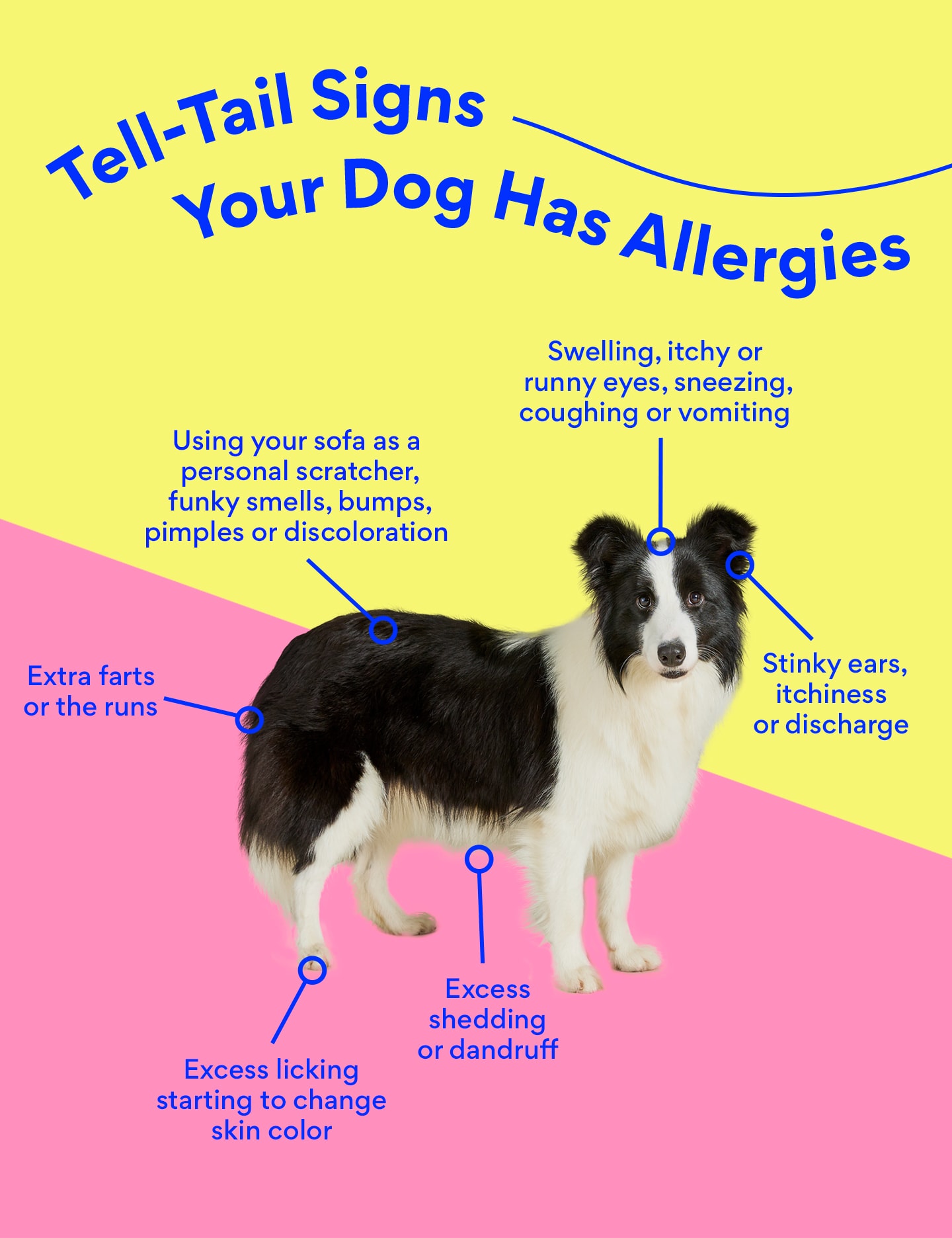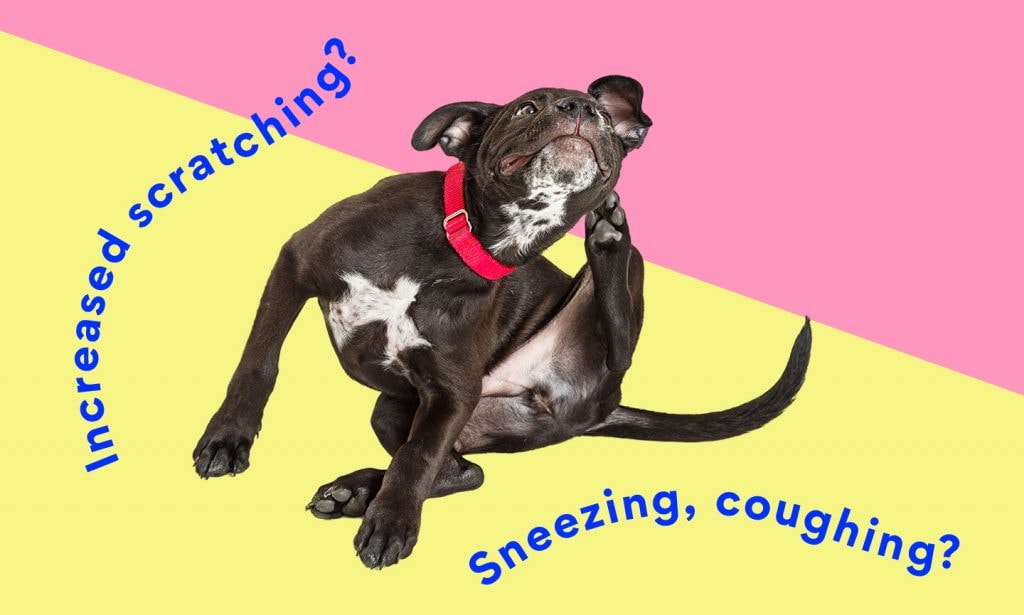Have you seen your pup scratching more? How about hair loss? What you might be seeing your poor pup suffer through are allergies, which are fairly common in dogs and can manifest in many ways, from skin and ear infections to itchy and red skin.
Fortunately, there are many options for allergy relief in dogs, including topical therapy, medications, prescriptions, and nutritional management. And we’ll discuss it all.
Of course, it is always advised to talk to your veterinarian before starting any treatment for allergies and to work with your veterinarian to determine and eliminate the root cause of allergies in your dog, if possible.
In This Guide:
Diagnosing Dog Allergies
Veterinarians group skin allergies in dogs into three main categories:
1 Flea allergy dermatitis
This is caused by an allergy to flea saliva and is the most common type of allergic reactions in dogs.
- The classic sign of flea allergy dermatitis (FAD) in dogs is hot spots, either around the base of the tail or around the neck.
- Dogs who are allergic to fleas are so itchy that they attack their own skin, pull out hair, and make raw, reddened areas of dermatitis.
Flea allergy dermatitis can be so intense that it takes just the bite of one passing flea to make a dog miserable.
2 Environmental allergies, such as seasonal allergies
This is called atopy, and about 30 percent of the U.S. dog population suffer from seasonal allergies.
- Dogs with atopy are seasonally itchy around their face, paws, and armpits.
- Recurrent ear infections are common with atopy.
Atopy is usually first seen in dogs ages 6 months to 3 years of age. Secondary skin infections with yeast and bacteria are common.
3 Food allergies
This is when a dog reacts to an ingredient in the food, usually a source of protein. While a lot less common than other issues, about 0.2% percent of dogs can suffer from food allergies. Dogs who have a food allergy often have concurrent flea allergy dermatitis and/or atopy as well.
- Dogs with a food allergy are itchy around their rump, armpits, groin, face, and in between their toes.
- The most common allergens in dogs are protein in nature and include:
- Beef (34% of dogs with food allergy)
- Diary (17% of dogs with food allergy)
- Chicken (15% of dogs with food allergy)
- Wheat (13% of dogs with food allergy)
- Soy (6% of dogs with food allergy)
- Lamb (5% of dogs with food allergy)
- Less-common allergies include corn (4%), egg (4%), pork (2%), fish and rice (2%)
Food allergies tend to be non-seasonal (year-round), and affected dogs are usually fed the offending ingredient for two years before developing signs.
In general, the following symptoms are associated with allergies in dogs:
- Excessive itchiness as evidenced by increased self-scratching, chewing, licking, and/or rubbing skin on carpet or furniture
- Red skin
- Hair loss
- Swelling of face, lips, eyelids, or ears
- Red bumps or pimples on skin (skin infection)
- Increased skin odor
- Thickened skin that is darkened (chronic yeast infection)
- Red paws that may be stained brown from excessive licking
- Increased odor, discharge and itching from ears (ear infection)
- Itchy, runny eyes
- Excessive dandruff
- Vomiting, diarrhea, excess gas (typically seen with food allergy)
- Sneezing

Treating Dog Allergies
If you’ve noticed any of these signs of allergies in your dog, there are a few ways to go about treating the symptoms, including topicals, medications, supplements, and prescriptions.
We’ll group treatments by type of allergies, starting with seasonal allergies (atopy or atopic dermatitis).
Check in with your veterinarian before treating your dog for allergies. They will recommend the best treatment for your pet.
Treating Seasonal Allergies

OTC Medications
Antihistamine
In some cases, your veterinarian may recommend trying an over-the-counter (OTC) antihistamine for your dog. These products are branded for humans and are not currently FDA approved as a veterinary medication.
However, the active ingredients are utilized commonly in the veterinary field and veterinarians can legally prescribe human drugs in animals in certain situations. This is called extra-label, or sometimes off-label use, because this use isn’t described on the drug label.
It’s important to note that not all human OTC medications are safe for animals, so you should never give a human medication to your pet unless under the specific guidance or direction of your veterinarian.
Furthermore, if your dog has a skin infection, external parasites, or food allergies, using an over-the-counter product may not help and may make it worse. If your dog is not responding, consult with your veterinarian.
Below are commonly prescribed OTC antihistamine options followed by their effectiveness at treating dogs with seasonal allergies (atopy):
- Cetirizine (Zyrtec®): 15%
- Chlorpheniramine: 8.9–10%
- Diphenhydramine (Benadryl®): 6.7%
- Hydroxyzine: 6.7–10%
- Loratadine (Claritin®): 0%
Topicals: Wipes, Shampoos, Mousses, Spray, Ointment
If your dog has seasonal allergies, then adding a topical to their treatment plan can be very helpful in preventing itching.
When bathing a dog for allergies, it is important to leave the lather on your dog for five to 10 minutes before rinsing and to thoroughly rinse the shampoo with cool water. Do not use hot water because it can dry their skin and make the itching worse. Aim for bathing itchy dogs no more than one to two times per week to control itching.
Discuss the addition of any topical to your dog’s treatment plan with your vet and follow their specific directions.
Supplements
Omega-3 Fatty Acids
Some dogs with seasonal allergies respond well to fish oil supplementation. Studies have shown that fish oil supplements, like the Vibeful™ Wild Alaskan Salmon Oil Skin & Coat Supplement, help reduce inflammation associated with skin allergies and help skin cells maintain a strong barrier against allergens.
You can give a dog too much fish oil, however, and fish oil is not indicated for all dogs. So, consult with your veterinarian on the appropriate dosage before giving fish oil to your dog.
The omega-3 fatty acids that help dogs with allergies are EPA (eicosapentaenoic acid) and DHA (docosahexaenoic acid). While dogs can convert GLA (gamma-linolenic acid) and ALA (gamma-linolenic acid and alpha-linolenic acid, respectively—the fatty acids found in evening primrose oil and flaxseed), they do so poorly, and benefit the most from fatty acid supplementation from fish or krill oil.
Also, many OTC fish oil products do not have high enough concentration of omega-3 fatty acids to help with allergies. Ask your vet for a specific dosage for your dog.
Probiotics
Some dogs with seasonal allergies benefit from taking a probiotic.
Allergies are due to inflammation and an abnormally hyper reactive immune system. The largest immune system in the body is called the GALT, and it is in the gut. Unhealthy or inflamed intestines with abnormal gut bacteria can contribute to allergies, which is why supplementing an allergic dog with probiotics may help reduce inflammation in the body and rebalance their gut immune system.
Do not supplement dogs with human probiotics as human gut bacteria is different from canine. Use a canine-specific product, like the Vibeful Allergy & Immune Support Soft Chews Supplement.
Prescription Medicine
Sometimes, OTC options for dog allergies are not enough, and you need something from your veterinarian that is prescription-strength to stop the itch. Fortunately, there are many products available that can be used alone or in combination with home remedies for dog allergies to provide the right amount of relief for your dog, including:
- Prescription topical treatments
- Prescription oral treatments
- Allergy shots
Always make sure you tell the vet about any current treatments, medications, or topicals you are using on your pet, as they can potentially interact with prescription meds.
Topical Treatments
If your dog has an itchy, red hot spot, Animax® Ointment (a prescription topical treatment that combines a corticosteroid, an antifungal, and an antibiotic) may help.
Topical sprays containing a steroid, like this miconazole nitrate spray, are often prescribed for local itchy hot spots as well.
Oral Treatments
If OTC oral antihistamines, fish oils, and topical products aren’t cutting it, then it’s time to explore prescription dog allergy treatment options for your itchy dog.
In the old days, the only oral prescription options available were steroids, like prednisone, prednisolone, triamcinolone, and betamethasone. While these medications did stop allergy symptoms, they also came with a whole host of negative side effects, including increased appetite, increased water consumption and urination, and increased susceptibility to infections, to name a few. Steroids are also less effective with food allergies.
Oral and injectable steroids are still used and prescribed in some dog allergy cases, but your vet will help decide if they are the best option for your pet.
Atopica™
Atopica™ is the brand name for cyclosporine, an FDA approved medicine for dogs with atopic dermatitis.
- Atopica™ is generally considered safe but can cause vomiting, diarrhea, or loss of appetite in some dogs. Your veterinarian may recommend keeping Atopica™ in the freezer to help lower the chance of negative side effects.
- Atopica™ must be given one to two hours before food or two hours after food.
- Most veterinarians will require annual bloodwork and an exam to fill this prescription.
- Atopica™ takes four to six weeks to provide relief, and steroids may be prescribed to your dog in the interim to control allergy symptoms.
Learn more about Atopica™.
Apoquel®
Apoquel® is another newer prescription allergy relief for dogs that starts working in four hours and helps stop the itch within 24 hours.
- Apoquel® may be prescribed seasonally or year-round, depending on your dog’s level of itch and allergies.
- It works by targeting and inhibiting the itch and inflammation signaling pathway.
- It’s typically administered twice daily for up to 14 days, and then once daily for maintenance. It can be given with or without food.
- Apoquel® should not be given to dogs with existing parasitic skin infestations or pre-existing cancers.
Learn more about Apoquel®.
Temaril-P™
Temaril-P™ is an oral prescription allergy medication that combines the antihistamine trimeprazine with the steroid prednisolone.
- This medication can be given to control seasonal or flea allergies.
- Temaril-P™ contains a low dose of steroids, so some side effects of steroids, such as increased drinking and urinating, potbelly, poor wound healing, and changes in their hair coat, may be seen.
Learn more about Temaril-P™.
Allergy Shots
If your dog has moderate severe allergies or requires daily medication, your vet may recommend allergy injections.
There are two main allergy shots available:
- Traditional allergy shots created by a skin or blood test
- General prescription option, Cytopoint®
Traditional Allergy Shot
The traditional allergy shot requires that you take your dog either to your local veterinarian or a veterinary dermatologist for allergy testing.
- Allergies are tested with a blood test or with a skin prick test. The skin prick test is considered more accurate and is usually only done by veterinary dermatologists.
- Once the test is done, an allergy serum is created.
- This allergy serum is administered via a series of injections and is intended to desensitize your dog over time to the allergens that cause them grief.
These allergy shots, otherwise known as hyposensitization subcutaneous immunotherapy, are the only way to truly reduce the instances of allergy symptoms. All other treatments are aimed at controlling symptoms.
Cytopoint®
Cytopoint® is another option that is administered as an injection by your veterinarian. It starts providing relief within one to three days and controls allergic itching for four to eight weeks.
- Cytopoint® works by targeting and neutralizing interleukin 31 (IL-31), a chemical messenger in your dog’s body that makes him itchy.
- Cytopoint® is only available through your local veterinarian and has a low incidence of side effects.
- It may be a good option if your dog has moderate to severe allergies or cannot tolerate oral medications.
Learn more about Cytopoint®.
Treating Flea Allergy Dermatitis

All of the above treatments may be useful in the treatment of flea allergy dermatitis. But for this type of allergy, it’s also important to ensure your furry friend is on year-round flea prevention. Your vet can help you determine the best type of flea prevention for your specific pet.
Here are some common options to discuss with your vet:
- Oral monthly preventative
- Oral medication for infestation (only lasts 24 hours)
- Topical monthly preventative
- Flea and tick collar (lasts eight months)
Treating Dog Food Allergies

Even though food allergies are less common in dogs than atopy or flea allergy, they can still occur.
If your dog has allergies year-round or has itchy skin that flares after eating certain foods, your dog may have a food allergy and may need dog food specifically formulated for dogs with allergies. Your vet will recommend the best diet for your pet.
Here are the basics for treating dog food allergies:
- Food elimination trial
- Hypoallergenic diet
- Hydrolyzed diet
- Novel protein diet
Food Elimination Trial
Food allergies can only be diagnosed by a food elimination trial.
The gist of a food trial is this:
- You work with your veterinarian to choose a prescription hypoallergenic diet for your dog (more on that below).
- After you slowly transition your dog to the new food over three to five days, you will feed only that food for eight to 10 weeks. That means that nothing else other than the hypoallergenic food will go in your dog’s mouth—no other treats, table food, flavored medications, or chews, etc.
- Your dog must consume only that food.
Hypoallergenic Diet
The reason you must only feed the hypoallergenic diet for eight to 10 weeks is to diagnose a food allergy.
Because it takes about 20 days for canine epidermis (skin) to turn over and at least six weeks for previous allergens to clear out, diet trials must last eight to 10 weeks.
If all the itching goes away on the new diet, then it is likely that your dog has a food allergy. If that is the case, then you have two options:
- Stay on the hypoallergenic diet.
- Or slowly start to reintroduce foods into your dog’s diet and see if the symptoms return.
Most pet parents understandably don’t want the itching to return, so they elect to keep feeding their dog the hypoallergenic diet.
If your veterinarian has recommended a diet trial, it’s important to follow their food recommendations precisely.
Over-the-counter diets are not considered good hypoallergenic choices for food trials because they are often manufactured on machines that make other diets.
Hypoallergenic diets generally are created on dedicated machines that are meticulously cleaned to prevent cross-contamination with allergens.
Hydrolyzed Diets vs. Novel Protein Diets
There are two main types of food to choose from for diet trials:
- Hydrolyzed diets, which are foods that are manufactured to remove allergens
- Novel protein diets, where you feed your dog a protein and carbohydrate that they have never eaten before
Your vet will determine the best diet for your dog.
Treating the Environment

If you have a dog with allergies, then you also need to think about treating the environment your dog lives in, especially if your dog suffers from flea allergies or atopy. They include:
- Flea control
- Reduce expose to allergens
- Combination of therapies
Flea Control
If your dog has a flea allergy, then the bite of just one flea can drive them crazy.
Use flea control on all dogs and cats in the household consistently throughout flea season to keep flea allergies under control.
Be sure you use a flea and tick treatment formulated specifically for each type of pet. In other words, don’t give your cat a flea and tick treatment formulated for dogs, and vice versa.
Reduce Exposure to Allergens
If your dog is prone to seasonal allergies, then you need to reduce exposure to allergens.
- Use a HEPA filter in your furnace.
- Plug in some air purifiers.
- Cover bedding with an allergen barrier.
- Wash pet bedding once a week during allergy season with a gentle, hypoallergenic laundry detergent.
Combination of Therapies
So, what can you give your dog for allergies? Every dog is unique, and causes and severity can vary, so the answer might be more complicated than you may have thought.
Controlling allergies takes some trial and error and usually requires a combination of therapies.
Working with your veterinarian, you can discover what to give your dog for allergies and stop the itching for good.
FAQs About Dog Allergies

Q: What causes dog allergies?
A: In dogs, allergies can be caused by pollen, dust, mold, dander, and other allergens, just like in humans. Dogs can also be allergic to flea saliva when they are bitten by fleas, and insect bites and stings. Dogs can also develop allergies to ingredients in their food, resulting in itchy skin and digestion abnormalities.
Q: Can dog allergies go away?
A:Once a dog develops an allergy, it typically doesn’t go away on its own. Treatment is aimed at reducing itching and avoiding the offending allergen as much as possible.
The only way to really minimize allergies is by having a dog tested for allergens and then started on a series of allergy shots, where a dog receives a series of injections that contain very small amounts of allergen, thereby desensitizing the dog to the allergen over time and curing the allergic response.
Shots won’t cure allergies, but they can greatly enable the body to get used to them. In time, symptoms will get better, and the pet may not have symptoms as often.
Q: Can dog allergies cause diarrhea or coughing?
A: In dogs, the most common symptoms associated with allergies are those related to the skin, i.e., itching, scratching, and hair loss.
In some cases, allergies can also affect the digestive system such as when a dog eats something they are allergic to, which can cause skin signs and digestive signs, including vomiting, diarrhea, or excessive gas.
Q: Can you give a dog Benadryl®?
A: Yes, in some cases, your veterinarian may recommend Benadryl® for your dog. However, it is only effective to treat allergies in approximately 7% of cases.
If your dog is itchy, talk to your vet about the options.
Q: Can you give a dog Claritin®? If so, how much Claritin® can I give my dog?
A: While plain Claritin® is not toxic to dogs, it’s not generally considered effective for canine allergies.
If your dog is having itchiness or signs of allergies, talk with your vet about the best option for your pup.
Q: What is the difference between Benadryl® and Claritin®?
A: While both Benadryl® and Claritin® are antihistamine medications, the active ingredients are different.
Benadryl® contains diphenhydramine, and Claritin® contains loratadine.
Both are considered low in efficacy for canine allergies: Benadryl® is 6.7% effective, while Claritin® is 0% effective.
Q: Can you give dogs Pepto Bismol® pills?
A: Never give human OTC medication unless specifically directed to do so by your veterinarian.
If your pet is having diarrhea, vomiting, or anorexia, please call your veterinarian to determine the next best steps.
Q: Can you give a dog Zyrtec®? If so, how much Zyrtec® can I give my dog?
A:The active ingredient in Zyrtec® is cetirizine, which has been shown to be about 15% effective in dogs with allergies.
Never give OTC human medication unless directed to do so by your veterinarian. If your dog is itchy or showing signs of allergies, please reach out to your vet to discuss the right medication for your pet.
There are no "stupid" questions when it comes to your pet’s health. If you suspect your pet is sick, please call your vet immediately. For health-related questions, always consult your regular veterinarian when possible as they can make the best recommendations for your pet. Next, learn more about fall allergies in dogs.
This content was medically reviewed by Chewy vets.
Share:



























